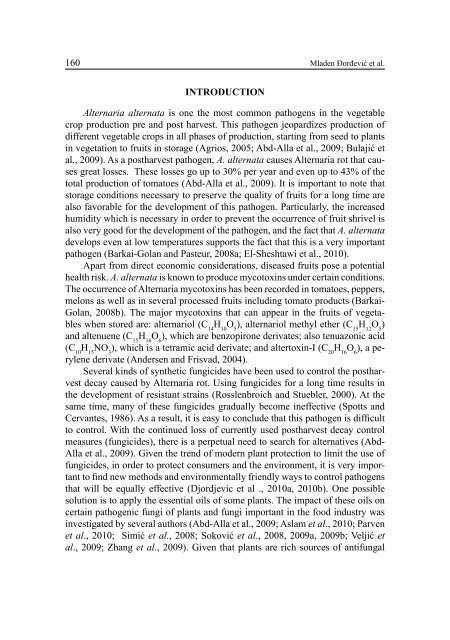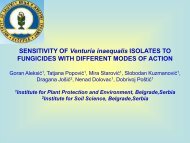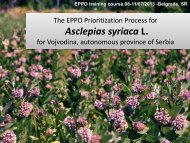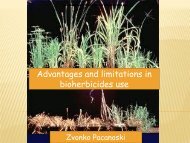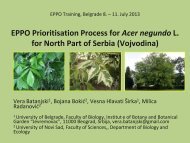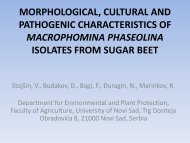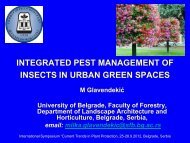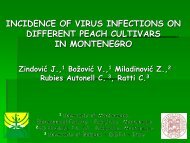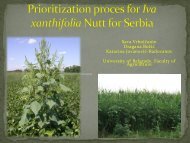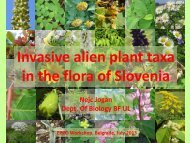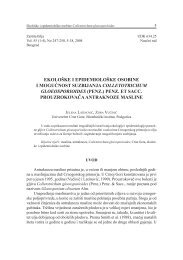ZAŠTITA BILJA PLANT PROTECTION
Vol.62 (3) - Izbis
Vol.62 (3) - Izbis
You also want an ePaper? Increase the reach of your titles
YUMPU automatically turns print PDFs into web optimized ePapers that Google loves.
160 Mladen Đorđević et al.<br />
INTRODUCTION<br />
Alternaria alternata is one the most common pathogens in the vegetable<br />
crop production pre and post harvest. This pathogen jeopardizes production of<br />
different vegetable crops in all phases of production, starting from seed to plants<br />
in vegetation to fruits in storage (Agrios, 2005; Abd-Alla et al., 2009; Bulajić et<br />
al., 2009). As a postharvest pathogen, A. alternata causes Alternaria rot that causes<br />
great losses. These losses go up to 30% per year and even up to 43% of the<br />
total production of tomatoes (Abd-Alla et al., 2009). It is important to note that<br />
storage conditions necessary to preserve the quality of fruits for a long time are<br />
also favorable for the development of this pathogen. Particularly, the increased<br />
humidity which is necessary in order to prevent the occurrence of fruit shrivel is<br />
also very good for the development of the pathogen, and the fact that A. alternata<br />
develops even at low temperatures supports the fact that this is a very important<br />
pathogen (Barkai-Golan and Pasteur, 2008a; El-Sheshtawi et al., 2010).<br />
Apart from direct economic considerations, diseased fruits pose a potential<br />
health risk. A. alternata is known to produce mycotoxins under certain conditions.<br />
The occurrence of Alternaria mycotoxins has been recorded in tomatoes, peppers,<br />
melons as well as in several processed fruits including tomato products (Barkai-<br />
Golan, 2008b). The major mycotoxins that can appear in the fruits of vegetables<br />
when stored are: alternariol (C 14<br />
H 10<br />
O 5<br />
), alternariol methyl ether (C 15<br />
H 12<br />
O 5<br />
)<br />
and altenuene (C 15<br />
H 16<br />
O 6<br />
), which are benzopirone derivates; also tenuazonic acid<br />
(C 10<br />
H 15<br />
NO 3<br />
), which is a tetramic acid derivate; and altertoxin-I (C 20<br />
H 16<br />
O 6<br />
), a perylene<br />
derivate (Andersen and Frisvad, 2004).<br />
Several kinds of synthetic fungicides have been used to control the postharvest<br />
decay caused by Alternaria rot. Using fungicides for a long time results in<br />
the development of resistant strains (Rosslenbroich and Stuebler, 2000). At the<br />
same time, many of these fungicides gradually become ineffective (Spotts and<br />
Cervantes, 1986). As a result, it is easy to conclude that this pathogen is difficult<br />
to control. With the continued loss of currently used postharvest decay control<br />
measures (fungicides), there is a perpetual need to search for alternatives (Abd-<br />
Alla et al., 2009). Given the trend of modern plant protection to limit the use of<br />
fungicides, in order to protect consumers and the environment, it is very important<br />
to find new methods and environmentally friendly ways to control pathogens<br />
that will be equally effective (Djordjevic et al ., 2010a, 2010b). One possible<br />
solution is to apply the essential oils of some plants. The impact of these oils on<br />
certain pathogenic fungi of plants and fungi important in the food industry was<br />
investigated by several authors (Abd-Alla et al., 2009; Aslam et al., 2010; Parven<br />
et al., 2010; Simić et al., 2008; Soković et al., 2008, 2009a, 2009b; Veljić et<br />
al., 2009; Zhang et al., 2009). Given that plants are rich sources of antifungal


